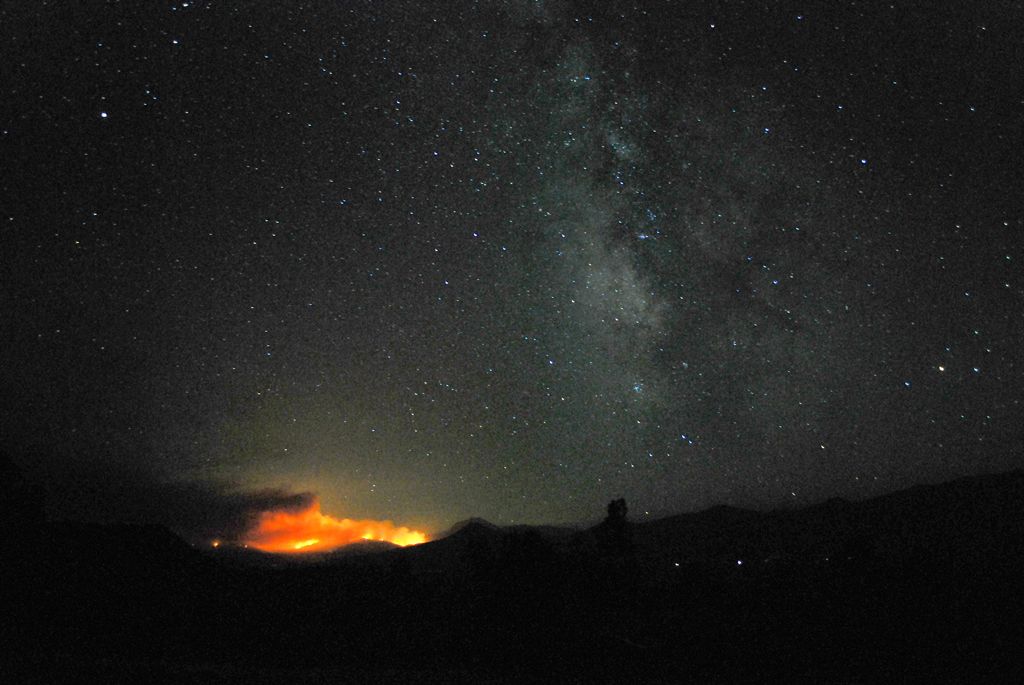
September 10, 2021, Mountain View, CA – The Allen Telescope Array, an ensemble of 42 antennas used in the search for extraterrestrial intelligence (SETI), is once again threatened by wildfires. The scientists and engineers normally on-site have been evacuated as a precautionary measure, and in response to an order from the Shasta County Sheriff’s Office.
The Dixie Fire, which is currently approximately 12 miles south of the Array, covers just short of a million acres, or an area larger than the state of Rhode Island. It ranks as the second-largest fire in California history, just shy of last year’s August Complex fire. Now 59 percent contained, it is one of eight major conflagrations in northern California.
It is an unfortunate fact that environments that are suitable for radio telescopes – including the Allen Telescope Array – are also frequently places where wildfires are commonplace. Since microwaves, the type of radio signals sought by the Array, are not hampered by Earth’s atmosphere, there’s no reason to place such instruments on mountain tops, as is done for optical telescopes.
But like their mirror-and-lens cousins, radio telescopes are generally located in rural areas. The signals sought by the Allen Array are presumed to be extremely faint, and radio quiet is a necessity. The Hat Creek Radio Observatory, where the Array is located, was established in 1959 and is now run by the SETI Institute. It was deliberately situated in a region of low population density. The surrounding landscape consists of pasture and forest land. On most days there are more cattle near the site than people.
According to Alex Pollak, the Array’s Science and Engineering Operations Manager, the fire’s slow northward march has provoked the need for evacuation. Anticipating the possibility that it might reach the antennas; the observatory staff contacted the U.S. Forest Service’s Fire Department to prepare the site against eventual damage. Two teams from the Forest Service, about a dozen people in total, removed brush from near the antennas. Trees in the area were pruned of any branches lower than ten feet above the ground.
This is not the first time the Array has been threatened. In the summer of 2014, the so-called Eiler fire reached State Highway 89, approximately two miles from the antennas. The mom-and-pop Circle K restaurant, the only public dining facility in Hat Creek, met its end in that conflagration.
The Allen Telescope Array is a unique facility. It is the only radio telescope constructed with SETI as a principal activity. It’s 42 telescopes are currently being refurbished with more sensitive receivers and follow-on electronics that will greatly speed the search for signals that would prove the presence of technological societies in other star systems. This upgrade is funded by Franklin Antonio, a co-founder of the California semiconductor company, Qualcomm.
As of writing, there are more than 4,000 firefighters battling the Dixie Fire, and the hope is that it will not reach the Observatory. But as Pollak notes, climate change has made “the entire west coast more susceptible to fire. The situation is not getting better.”
About the SETI Institute
Founded in 1984, the SETI Institute is a non-profit, multidisciplinary research and education organization whose mission is to lead humanity’s quest to understand the origins and prevalence of life and intelligence in the universe and share that knowledge with the world. Research at the SETI Institute encompasses the physical and biological sciences and leverages expertise in data analytics, machine learning and advanced signal detection technologies. The SETI Institute is a distinguished research partner for industry, academia and government agencies, including NASA and NSF.
Contact:
Alex Pollak
Hat Creek Radio Observatory
apollak@seti.org
Tel: +1 530 552-9744
Rebecca McDonald, Communications Director
SETI Institute
rmcdonald@seti.org
Tel: +1 650 960-4526
DOWNLOAD FULL PRESS RELEASE HERE.





